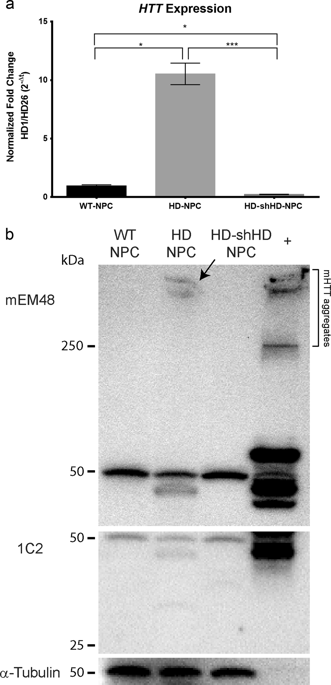npj Regenerative Medicine ( IF 7.2 ) Pub Date : 2019-03-26 , DOI: 10.1038/s41536-019-0066-7 In Ki Cho , Carissa Emerson Hunter , Sarah Ye , Alvince Learnz Pongos , Anthony Wing Sang Chan

|
Huntington’s disease (HD) is a dominantly inherited monogenetic disorder characterized by motor and cognitive dysfunction due to neurodegeneration. The disease is caused by the polyglutamine (polyQ) expansion at the 5′ terminal of the exon 1 of the huntingtin (HTT) gene, IT15, which results in the accumulation of mutant HTT (mHTT) aggregates in neurons and cell death. The monogenetic cause and the loss of specific neural cell population make HD a suitable candidate for stem cell and gene therapy. In this study, we demonstrate the efficacy of the combination of stem cell and gene therapy in a transgenic HD mouse model (N171-82Q; HD mice) using rhesus monkey (Macaca mulatta) neural progenitor cells (NPCs). We have established monkey NPC cell lines from induced pluripotent stem cells (iPSCs) that can differentiate into GABAergic neurons in vitro as well as in mouse brains without tumor formation. Wild-type monkey NPCs (WT-NPCs), NPCs derived from a transgenic HD monkey (HD-NPCs), and genetically modified HD-NPCs with reduced mHTT levels by stable expression of small-hairpin RNA (HD-shHD-NPCs), were grafted into the striatum of WT and HD mice. Mice that received HD-shHD-NPC grafts showed a significant increase in lifespan compared to the sham injection group and HD mice. Both WT-NPC and HD-shHD-NPC grafts in HD mice showed significant improvement in motor functions assessed by rotarod and grip strength. Also, immunohistochemistry demonstrated the integration and differentiation. Our results suggest the combination of stem cell and gene therapy as a viable therapeutic option for HD treatment.
中文翻译:

干细胞和基因疗法的结合可改善亨廷顿舞蹈病小鼠的症状
亨廷顿舞蹈病(HD)是一种主要遗传的单基因疾病,其特征是由于神经退行性运动和认知功能障碍。该疾病是由亨廷顿(HTT)基因IT15外显子1的5'末端的聚谷氨酰胺(polyQ)扩增引起的,这导致突变型HTT(mHTT)聚集体在神经元中蓄积并导致细胞死亡。单基因原因和特定神经细胞群的丧失使HD成为干细胞和基因治疗的合适候选者。在这项研究中,我们证明了在使用恒河猴(猕猴)的转基因HD小鼠模型(N171-82Q; HD小鼠)中,干细胞和基因疗法相结合的功效)神经祖细胞(NPC)。我们已经从诱导性多能干细胞(iPSC)建立了猴子NPC细胞系,该细胞可以在体外以及在小鼠脑中分化为GABA能神经元,而不会形成肿瘤。野生型猴子NPC(WT-NPC),转基因HD猴子(HD-NPC)衍生的NPC,以及通过稳定表达小发夹RNA(HD-shHD-NPC)降低mHTT水平的基因修饰的HD-NPC,将它们移植到WT和HD小鼠的纹状体中。与假注射组和HD小鼠相比,接受HD-shHD-NPC移植的小鼠的寿命显着增加。通过旋转脚架和握力评估,HD小鼠中的WT-NPC和HD-shHD-NPC移植物均显示出运动功能的显着改善。同样,免疫组织化学证明了整合和分化。


























 京公网安备 11010802027423号
京公网安备 11010802027423号